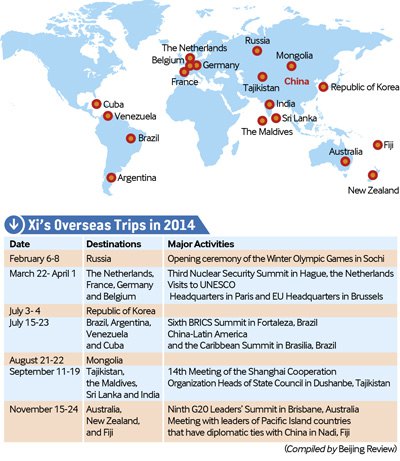|
The outside world paid close attention to Xi's speech. Some observers claim that the conference sent a message that China is giving up the late Chinese leader Deng Xiaoping's diplomatic stance of "keeping a low profile," while some others believe it is a kind of policy of mollification to the international community. These views are narrow and one-sided. China is dedicated to development under the current international system. In the meantime, it is becoming more active and confident in participating in international affairs. China strives to international situation instead of following the beaten path. China is in fact making efforts to incorporate its own progress much more closely with the world's development.
The resurgence of populism is one of the major features of the international situation in 2014. China's peaceful development strategy is also challenged by sentiments of ultra-nationalism and military adventurism at home. But Xi has determined to resist such distracting forces and kept a clear mind.
Adjusted scenarios
While focusing on Asia, Xi's diplomacy presents a trend of building strategic partnerships widely with both the East and the West, paving the way for China's status as a major country in the world.
Xi's diplomacy places particular emphasis on neighboring countries. His 2014 visits included trips to Russia, Mongolia and South Korea, respectively. When hosting the APEC Economic Leaders' Meeting, China also invited leaders of neighboring countries that are non-APEC members including Mongolia, Tajikistan, Pakistan, Myanmar, Cambodia, Laos and Bangladesh to Beijing for the dialogue devoted to strengthening interconnectivity partnerships.
Under Xi's leadership, China's diplomatic approach has moved away from overemphasizing stable China-U.S. relations to focusing on more balanced relations with major players in the international community. While exploring ways to build a new type of major-country relations with the United States featuring no conflict and no confrontation, China also actively deepens its strategic partnership with Russia, the EU and India, promoting the trend of multi-polarization. On the Ukraine crisis, China refuses to pick sides. It neither participates in the Western sanctions against Russia, nor does it join hands with Russia to confront with the West. Rather, it works to promote the settlement of the crisis through political dialogue.
Though China-U.S. relations have seen ups and downs in the past year due to friction over trade, human rights, cyber security, the South China Sea and Hong Kong issues, their overall bilateral ties have maintained positive momentum.
In November, U.S. President Barack Obama paid his second visit to China since taking office. Xi and Obama had in-depth talks, during which they reiterated the consensus on building a new type of major-country relations between the world's two largest economies. The two countries also agreed to enhance cooperation on a wide range of topics including climate change, investment and military exchanges.
However, within the United States there exists growing anxiety toward China's rapid development within the United States. Despite Obama's frequent reiteration that the United States welcomes a peaceful and prosperous China and has no intention of containing China, his administration acts as though they view China as a major competitor and insists on the advancement of its pivot-to-Asia strategy featuring military deployment in the Asia-Pacific region surrounding China. Thus, China-U.S. relations have many challenges remaining in the future.
Sharing profits
On August 8, in an interview with The New York Times columnist Thomas Friedman, Obama claimed that China had been a free rider for 30 years, and that no one expected China to play the role. Half a month later, when visiting Mongolia, Xi seemingly gave an indirect response to the U.S. accusation. During his address at the Mongolian parliament on August 22, Xi said, "China is willing to offer opportunities and room to Mongolia and other neighbors for common development. You can take a ride on our express train or simply hitchhike. All are welcome."
In fact, China not only sincerely welcomes its neighbors to share the fruits of its development but has also taken many concrete measures already. For example, it has tirelessly promoted the building of the Silk Road Economic Belt and the 21st-Century Maritime Silk Road that encompass a large number of Asian, European and African economies.
China has also announced a $40-billion Silk Road Fund to improve infrastructure in Asia. The "One Belt and One Road" initiatives both focus on Asian countries. Through them, China aims to build a "community of destiny" together with its neighbors by strengthening interconnectivity to provide these countries with more public goods.
In the meantime, China has also committed to a $50-billion investment of funds in the Asian Infrastructure Investment Bank in addition to a $41-billion contribution to the $100-billion emergency reserve fund to be launched by BRICS countries—Brazil, Russia, India, China and South Africa.
Another major move China takes in 2014 is expanding regional trade liberalization. In the past year, China substantially concluded bilateral free trade agreement (FTA) negotiations with South Korea and Australia, respectively. It has also sped up the negotiations on an upgraded China-ASEAN FTA and the Comprehensive Economic Partnership in East Asia.
At the foreign affairs meeting in November, Xi urged China's diplomatic service to give full consideration to both domestic and international markets, both domestic and foreign resources as well as both domestic and international rules; to act in good faith and uphold justice; and to promote a new type of international relations featuring mutually beneficial cooperation.
The year of 2014 saw the ushering in of China's new diplomacy, yet the road ahead could be full of uncertainties. Will the "One Belt and One Road" initiatives come out of the geopolitical shadow? Can the Asia-Pacific free trade blueprint proposed by China be compatible with the U.S.-dominated Trans-Pacific Partnership trade agreement? Will the West put more pressure on China using human rights as an excuse? And can China-U.S. relations and China-Japan relations see more improvement in the future? Xi's leadership must confront all of these challenges step by step.
The author is an op-ed contributor to Beijing Review

| 